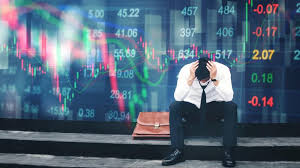Year-to-date, the S&P 500 is already down 4%, marking its worst start to a year since 2016. And with selling pressure increasing every single day, the big question on Wall Street right now is whether this is a run-of-the-mill correction in a bull market or the start of something more sinister.
It's probably the former. But it could be the latter. And that's why you need to "crash-proof" your portfolio right now.
But first, let's understand what's going on in the markets right now…
In short, it all comes down to interest rates. Simply put, the valuation of a stock is tied to interest rates. Higher interest rates go, lower goes stock valuations and vice versa.
For decades, interest rates were relatively high because inflation was relatively high, and to that end, stock valuations were relatively low.
But in 2008, the Fed slashed interest rates to zero to save the US economy from collapse. This was followed by 14 years of ultralow inflation that allowed ultralow interest rates to remain in place - and driven stock valuations to historically high levels.
In 2022, however, the story has changed. Inflation is red-hot for the first time since 2008, meaning that the era of ultralow interest rates - for the first time - is threatened by runaway inflation. This is problematic for stocks because they are still valuable such that interest rates will remain low for a longer period of time.
With fears that this may not happen, 2022 stocks have started in a sour mood.
What could Expect next..?
The way we look at things, there are three possible outcomes for the stock market in 2022. They are as follows, with probabilistic weightings:
- Bull Case (20% Chance): The market rises 20%. In this scenario, the Fed raises rates only once in March, after which inflation calms dramatically before their May meeting. The Fed proceeds not to raise rates for the rest of the year. Economic expansion remains vigorous against a backdrop of accommodative monetary policy, and rapidly falling inflationary pressures tend to expand corporate profit margins. In this scenario, our valuation model suggests a reasonable earnings multiplier for the S&P 500 of 22X and 2022 earnings per share of $250. This combination implies a year-end price target for the index of 5,500.
- Base case (70% chance): Stock flatline. In this scenario, the Fed raises rates in March, after which inflation calms down, but not so fast as to frighten the Fed. Fed hikes again in May. Then, inflation really starts to subside. The Fed has paused its rate hikes for the remainder of the year. Economic expansion continues to be good, but continued inflation in the first half of the year has dampened corporate profit margins partly. In this scenario, our valuation model suggests a reasonable earnings multiplier for the S&P 500 of 21X and 2022 earnings per share of $230. This combination implies a year-end price target of 4,830 for the index.
- Bear case (10% chance): The market crashes 20%. In this scenario, the Fed hikes rates twice in March, but inflation remains red-hot in April and May. The Fed hikes rates three times at the end of the year for a total of five rate hikes in 2022. The sum of those rate hikes drives inflation down but, at the same time, hurts economic growth. Corporate profit margins are also lowered by stubbornly heated inflationary trends and rising labor and material costs. In this scenario, our valuation models suggest a reasonable earnings multiplier for the S&P 500 of 18X and 2022 earnings per share of $200. This combination implies a year-end price target of 3,600 for the index.
Overall, the stock market is likely to "recover" in 2022, although investors should not expect huge returns by investing in the index, and the risk of a market crash is as high today as it was during the Covid- 19 pandemic of 2020. appeared in the beginning.
The investment implication is that investing in the S&P 500 in 2022 is a bad investment.
good investment? Well, it would be investing in high-growth tech stocks.
It's a contradictory thesis, I know, but it's also the correct thesis. This is because these stocks are not a win-win situation.
Let the bull case come to the fore. As the past decade has proven, ultralow interest rates for high-multiple tech stocks are ultrabullish. So, in the event that the Fed raises rates only in 2022, high-growth tech stocks will fly higher between now and the end of the year.
Suppose the base case comes up. High-growth tech stocks have already been washed out and revalued for significantly higher rates. Moderate high rates coupled with steady economic expansion is an extremely favorable backdrop for those stocks. If the base case turns out to be true, high-growth tech stocks will benefit from both multiple expansions and earnings growth -- meaning they'll be the biggest winners on Wall Street in 2022.


.jpeg)
.jpeg)

0 Comments